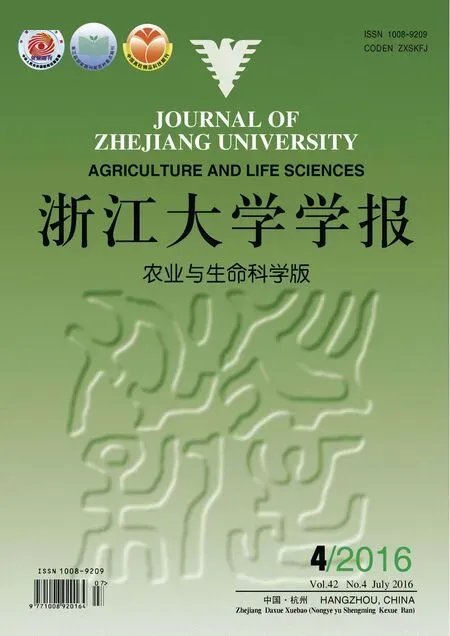椰衣和椰壳生物质炭的制备及其对溶液中Pb2+的吸附
兰天, 楚颖超, 张玲玲, 赵文, 潘运舟, 张家玮, 朱治强, 吴蔚东*
(1.海南大学热带作物种质资源保护与开发利用教育部重点实验室,海口 570228;2.海南省农业科学院海南省耕地保育重点实验室,海口 571100)

椰衣和椰壳生物质炭的制备及其对溶液中Pb2+的吸附
兰天1,2, 楚颖超1, 张玲玲1, 赵文1, 潘运舟1,2, 张家玮1, 朱治强1, 吴蔚东1*
(1.海南大学热带作物种质资源保护与开发利用教育部重点实验室,海口 570228;2.海南省农业科学院海南省耕地保育重点实验室,海口 571100)
以椰衣和椰壳作为原材料,在300、500和700 ℃条件下热解制备生物质炭,表征其物理化学性质;同时,研究所制备的生物质炭对溶液中Pb2+的吸附特征与机制。结果表明:随着热解温度升高,所制备的生物质炭的含氧官能团减少,灰分、pH值、阳离子交换量、比表面积和碱性官能团的含量随之升高。热解温度升高可促进生物质炭对Pb2+的吸附;Langmuir模型可较好地描述所制备的生物质炭对Pb2+的等温吸附;在供试的6种生物质炭中,吸附量最高的是在700 ℃条件下制备的椰衣生物质炭,且优于大多数已报道的用其他材料制备的生物质炭。拟合发现,所制备的生物质炭的阳离子交换量和灰分含量是影响其吸附Pb2+的重要因子,在初始Pb2+质量浓度为200 mg/L条件下,椰衣生物质炭对Pb2+的稳定吸附量为9.83~13.91 mg/g,椰壳生物质炭为9.68~25.16 mg/g。这表明椰壳生物质炭吸附态Pb2+比椰衣生物质炭吸附态Pb2+更稳定。
椰衣; 椰壳; 生物质炭; 热解温度; 理化性质; 吸附; Pb2+
Summary Heavy metal pollution has become more and more serious with the development of industry. Heavy metals can accumulate in plants, and enter into human body through the food chain. Lead (Pb) is one of the most common heavy metal contaminants in the environment, usually discharged with waste water and waste gas. Accumulation of lead in the body can cause physical function disorder, and it is even more harmful to children. Therefore, it is very urgent to control the lead pollution. As a new type of adsorbent for soil heavy metal, biochar has a great advantage compared with other traditional materials. Biomass-derived biochar combines an effective removal of water contaminants with low cost of remediation. Many researchers used waste biomass crops and other materials to make biochar by pyrolysis at high temperature to remove heavy metals. The water movement on the biochar pores is affected by metal adsorption, which is a novel and promising technique to identify the nature of biochar-metal bonds at the solid-liquid interface.
However, few researches were reported using common tropical biomass waste such as coconut shell and coconut fiber to prepare biochars. The coconut fiber become thick after matured, and the loose brown fibrous layers are soft and elastic, mainly are composed of hard stratum corneum. The coconut shell and coconut fiber are abundant, cheap and easy to collect in Hainan Province. Therefore, study on the adsorption of lead by biochars prepared from coconut shell and coconut fiber has a great significance to control heavy metal pollution. The objectives of this study were to: 1) characterize the biochars prepared from coconut shell and coconut fiber under different temperatures; 2) determine the adsorption characteristics and mechanisms of Pb2+on biochars.
Biochars were prepared by pyrolyzing coconut fiber and coconut shell at the temperatures of 300, 500 and 700 ℃ respectively, and their physical and chemical properties were analyzed.
The results of Fourier transform infrared spectroscopy and element contents indicated that, the carbonation degree of the biochars increased with the pyrolysis temperature, while the amount of oxygen-containing functional groups decreased. In addition, the surface area, ash content, pH, cation exchange capacity (CEC) and basic functional group content enriched with the pyrolysis temperature. The adsorption of Pb2+by biochars derived from coconut fiber and coconut shell was fitted better with Langmuir model. As the pyrolysis temperature increased from 300 to 700 ℃, the amount of Pb2+adsorbed on the biochars gradually increased. Among the six kinds of biochars, the coconut fiber biochar prepared at 700 ℃ had the highest adsorption amount of 180.438 mg/g, which was better than many adsorption materials that reported previously. The CEC and ash content were important factors affecting the adsorption deduced from the fit curve. Under the condition of initial Pb2+concentration with 200 mg/L, the saturated adsorption amounts of coconut fiber and coconut shell biochars were 44.89-96.08 mg/g and 15.82-61.77 mg/g, respectively. The saturated adsorption amount of coconut fiber biochars was higher than that of the coconut shell biochars. However, the stable adsorption amounts of coconut fiber and coconut shell biochars were 9.83-13.91 mg/g and 9.68-25.16 mg/g, respectively.
In conclusion, the different preparation temperatures can directly affect the physical and chemical properties of biochars. Different raw material sources and pyrolysis temperatures have a great influence on the adsorption capacity of Pb2+, and the largest amount of lead adsorption material is YA700(180.438 mg/g). In addition, different raw material sources and pyrolysis temperatures have a great influence on the stable adsorption quantity of lead, and the adsorption of Pb2+on the coconut shell biochar is more stable than coconut fiber biochar.
生物质炭是一种在限氧条件下通过热解制备的碳材料[1-2],可以作为土壤改良剂增加土壤碳汇,提高土壤保水保肥能力[3-4]。同时,生物质炭可以有效地钝化环境中的重金属和有机污染物,降低有害物质的生物有效性,提高作物产量[5]。与传统材料相比,生物质炭作为一种重金属吸附剂有很大的优势,是一种高效、廉价的重金属吸附材料。利用农业废弃物在高温条件下制备生物质炭,研究其在水溶液中对重金属的吸附越来越受到人们的重视[6-7]。如XU等[8]研究发现:在200 ℃条件下利用牛粪制备的生物质炭(DM200)对溶液中Cu2+、Zn2+和Cd2+的吸附量分别为48.4、31.6和31.9 mg/g;而DM350对溶液中Cu2+、Zn2+和Cd2+的吸附量分别为54.4、32.8和51.4 mg/g。生物质炭之所以能够吸附重金属,是由于生物质炭表面具有丰富的极性官能团,例如羧基、氨基等,这些官能团能够有效地去除溶液中的重金属;同时,生物质炭表面具有可以和重金属发生沉淀的磷酸根和碳酸根离子[9]。
工农业的快速发展带来越来越严重的重金属污染,重金属在植物体内富集,可通过食物链进入人体[10]。如Pb通过工业废水和废气排放进入环境中,是一种很常见的重金属污染物。Pb在人体内不断积累可以导致身体功能障碍,对儿童的生长发育有很大的负面影响。因此,采取有效的手段治理Pb污染变得尤为迫切[6]。生物质炭对Pb的等温吸附数据可以用Langmuir和Freundlich模型很好地拟合[11]。
目前,利用热带生物资源制备生物质炭用以去除溶液中重金属的研究较少。海南省椰壳和椰衣资源丰富,价格便宜,取材方便。椰子成熟以后,中层果皮椰衣为厚而疏松的棕色纤维层,质软、富有弹性,椰衣纤维属于硬质纤维,弹性和韧性较强;内果皮即椰壳,为紧密而坚硬的角质层[12]。利用椰壳和椰衣制备生物质炭,研究其对溶液中Pb2+的吸附,对于利用热带生物资源修复重金属污染具有重要的理论和现实意义。
1 材料与方法
1.1生物质炭的制备
椰子废弃物取自海南省文昌市。将椰子擦洗干净,椰壳和椰衣分离,取成熟度一致的椰壳与椰衣足量,切成1 cm × 1 cm × 1 cm大小,在自然条件下风干1~2周。分别将一定量风干的椰壳和椰衣置于马弗炉中,在300、500和700 ℃下炭化4 h,冷却至室温后磨碎过2 mm筛,分别记为KA300、KA500、KA700、YA300、YA500、YA700(KA表示椰壳,YA表示椰衣;300、500和700分别表示生物质炭的制备温度),用密封袋保存,供后续试验使用[13]。
1.2生物质炭理化性质表征
利用元素分析仪(EA2400,美国PE公司)测定生物质炭中的C、H、O、N含量;用Boehm滴定法定量分析生物质炭中酸碱官能团的含量;用精密酸度计测定生物质炭的pH值(生物炭的质量与水的体积比为1/100);采用灼烧法测定生物质炭的灰分含量;利用1 mol/L中性乙酸铵法测定生物质炭中的阳离子交换量(cation exchange capacity,CEC)[14-15];采用KBr压片法制样,用红外光谱仪(TENSOR27,德国Bruker公司)测定椰壳生物质炭吸附剂的红外图谱,扫描范围400~4 000 cm-1,检测生物质炭中的官能团成分及含量;利用扫描电镜(S-3000N,日本日立公司)观察生物质炭的表面形貌特征。
1.3等温吸附试验
用Pb(NO3)2配置质量浓度为25、50、100、150、300和450 mg/L Pb2+溶液,以0.01 mol/L NaNO3为背景电解质,用0.1 mol/L HNO3和NaOH调节溶液pH值至5.0,称取0.050 0 g生物质炭于50 mL离心管中,分别加入25 mL已配置的不同质量浓度的Pb2+溶液,放入25 ℃恒温振荡箱中以200 r/min振荡24 h,过滤测定。每个处理设3个重复。分别用Freundlich和Langmuir模型拟合生物质炭在 25 ℃下对Pb2+的吸附等温线。Langmuir模型理论的假设条件为在均一表面进行的单分子层吸附,且被吸附的分子之间无任何相互作用;Freundlich模型描述的是多层吸附,在高浓度时吸附容量持续增加,常用于描述物理吸附。
Langmuir方程:Ce/Q=1/(b·Qm)+Ce/Qm。
(1)
Freundlich方程:lnQ=lnKf+1/n·lnCe。
(2)
其中:Ce为平衡浓度,mg/L;Q为平衡吸附量,mg/g;Qm为最大吸附量,mg/g;b为吸附平衡常数,L/mg,表示吸附剂的吸附位点对重金属离子的亲和力大小;Kf为吸附容量,mg/g;n为Freundlich常数,表示吸附强度大小[16],g/L。
1.4解吸试验
取在初始质量浓度200 mg/L下平衡吸附Pb2+的生物质炭0.05 g,分别使用25 mL去离子水和1.0 mol/L HCl溶液进行连续提取,然后置于25 ℃恒温振荡箱中以200 r/min振荡24 h,过滤后用火焰原子吸收法(M6,美国Termo Elemental公司)测定溶液中的Pb2+含量[17]。
1.5数据分析
试验所得数据采用SPSS 17.0进行分析,吸附数据采用Origin Pro 9.0进行拟合。
2 结果与分析
2.1生物质炭的理化性质
在不同热解温度下椰衣和椰壳生物质炭的理化性质存在明显差异(表1)。热解温度从300 ℃升到700 ℃,椰衣生物质炭的灰分含量从6.11%增加到11.08%,椰壳生物质炭的灰分含量从1.90%增加到3.26%,前者的灰分含量总体上高于后者。在不同温度下制备的生物质炭的CEC变化范围是36.53~92.36 cmol/kg;当热解温度为500 ℃时椰衣和椰壳生物质炭的CEC值达到最高,分别为92.36和49.71 cmol/kg;同时,椰衣生物质炭的CEC高于在相同温度下用椰壳制备的生物质炭。随着制炭温度的升高,椰衣和椰壳生物质炭的碱性官能团分别从0.43和0.21 mmol/g上升到0.73和0.45 mmol/g;酸性官能团则分别从1.04和0.62 mmol/g下降到0.42和0.19 mmol/g。这主要是由于羧基、酚羟基、内酯等含氧官能团含量下降导致的。生物质炭的pH值趋于中性或偏碱性,用2种原材料制备的生物质炭pH值随温度的升高分别从7.28和7.15上升到10.79和10.45。
表2是在不同热解温度下所获生物质炭的元素组成。当制备温度从300 ℃上升到500 ℃时,生物质炭的含C量显著上升,随着温度继续上升,其含量上升不再明显。椰衣生物质炭的含N量随着热解温度的上升而增加,椰壳生物质炭的含N量随着热解温度的上升先增加后减少。H元素含量随着热解温度的升高逐渐降低,H/C值随之下降;椰衣生物质炭的H/C值大于椰壳生物质炭。热解温度升高会提高生物质炭的芳香性;椰衣生物质炭的芳香性和极性比椰壳生物质炭高。在制备温度较高的条件下,O/C和(O+N)/C值较低。这反映出在高温条件下制备的生物质炭含氧官能团较少。在利用Boehm法的滴定结果中酸、碱官能团的变化规律也证实了这一点。

表1 生物质炭的物理化学性质
CEC:阳离子交换量;SBET:比表面积;(YA300,YA500,YA700):分别表示在300、500和700 ℃下用椰衣制备的生物质炭;(KA300,KA500,KA700):分别表示在300、500和700 ℃下用椰壳制备的生物质炭。
CEC: Cation exchange capacity;SBET: Specific surface area; (YA300, YA500, YA700): Coconut fiber biochars prepared at 300, 500 and 700 ℃, respectively; (KA300, KA500, KA700): Coconut shell biochars prepared at 300, 500 and 700 ℃, respectively.

表2 生物质炭的元素组成与原子比例
各生物质炭处理表示的含义详见表1注。
Please see footnote of Table 1 for details of each biochar treatment.

从图2可以看出:在扫描电镜下椰衣生物质炭表面呈蜂窝状,孔道结构完整;椰壳生物质炭表面没有固定的形态。随着热解温度的升高,生物质炭表面孔隙增多,断面变得无序,原有结构出现破坏现象。可以推断,随着热解温度升高,生物质炭有比表面积增大、微孔体积增加的趋势;对比表面积的测定结果也证实了这一点。当生物质炭的制备温度在500 ℃以下时,生物质炭的比表面积均小于5 m2/g,当制备温度达到700 ℃,椰衣和椰壳生物质炭的比表面积骤然增加到434.70和398.40 m2/g(表1)。
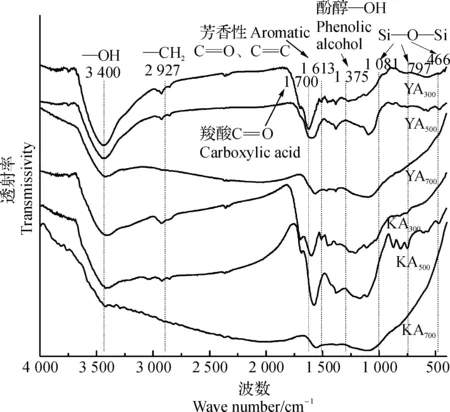
图1 椰衣和椰壳生物质炭的红外图谱Fig.1 Fourier transform infrared spectroscopy of biochars prepared by coconut fiber and coconut shell
2.2等温吸附线
图3是用Langmuir和Freundlich模型拟合在不同温度下制备的椰衣和椰壳生物质炭在25 ℃下对Pb2+的等温吸附线,表3是各参数的拟合结果。比较2种拟合模型的决定系数(R2)可知,Langmuir可以更好地描述不同热解温度制备的椰衣和椰壳生物质炭对Pb2+的吸附:表明其吸附过程为单分子层吸附[17]。在Langmuir模型中b值与吸附强度有关,b值越大表明吸附强度越大。椰衣生物质炭的吸附强度排序为YA700>YA300>YA500,椰壳生物质炭的吸附强度随着热解温度的升高而下降。所制备的生物质炭对Pb2+的最大吸附量(Qm)顺序为YA700>YA500>KA700>YA300>KA500>KA300。随热解温度的上升,用2种原材料制备的生物质炭对Pb2+的最大吸附量均呈现上升趋势;在相同热解温度条件下,椰衣生物质炭比椰壳生物质炭具有更大的Qm值。
2.3解吸试验
不同提取剂对生物质炭饱和吸附Pb2+后的解吸量见表4。去离子水解吸附的量代表物理方式的吸附量,其本质是静电吸附,与吸附材料的表面积有关[18]。HCl解吸出的Pb2+是生物质炭通过阳离子-π作用吸附以及和碳酸盐、磷酸盐发生沉淀[8]。生物质炭对Pb2+的稳定吸附量=平衡吸附量-HCl解吸附量-去离子水解吸附量。随着制炭热解温度的上升,相同原材料生物质炭对Pb2+的平衡吸附量随之增加。椰衣生物质炭对Pb2+的平衡吸附量为44.89~96.08 mg/g,椰壳生物质炭对Pb2+的平衡吸附量为15.82~61.77 mg/g。说明椰衣生物质炭比椰壳生物质炭具有更高的平衡吸附量。当热解温度从300 ℃上升到700 ℃时,用2种原材料制备的生物质炭对Pb2+的稳定吸附量呈现不同的变化趋势,椰衣生物质炭对Pb2+的稳定吸附量从13.91 mg/g减小到9.83 mg/g,椰壳生物质炭则从9.68 mg/g增加到25.16 mg/g。
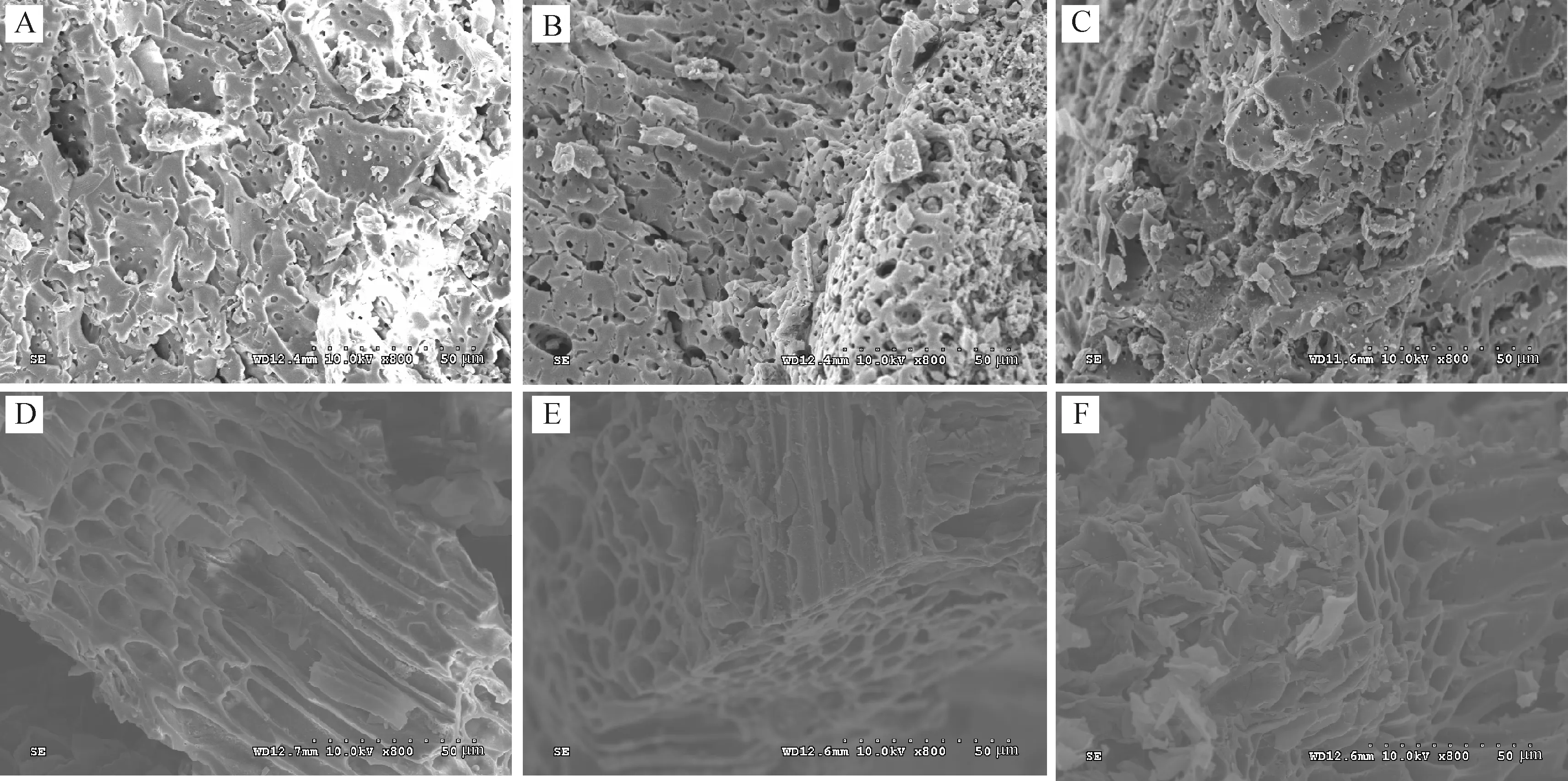
A:KA300;B:KA500;C:KA700;D:YA300;E:YA500;F:YA700。图2 椰衣和椰壳生物质炭的扫描电镜表面形态Fig.2 Scanning electron microscope images of biochars prepared by coconut fiber and coconut shell
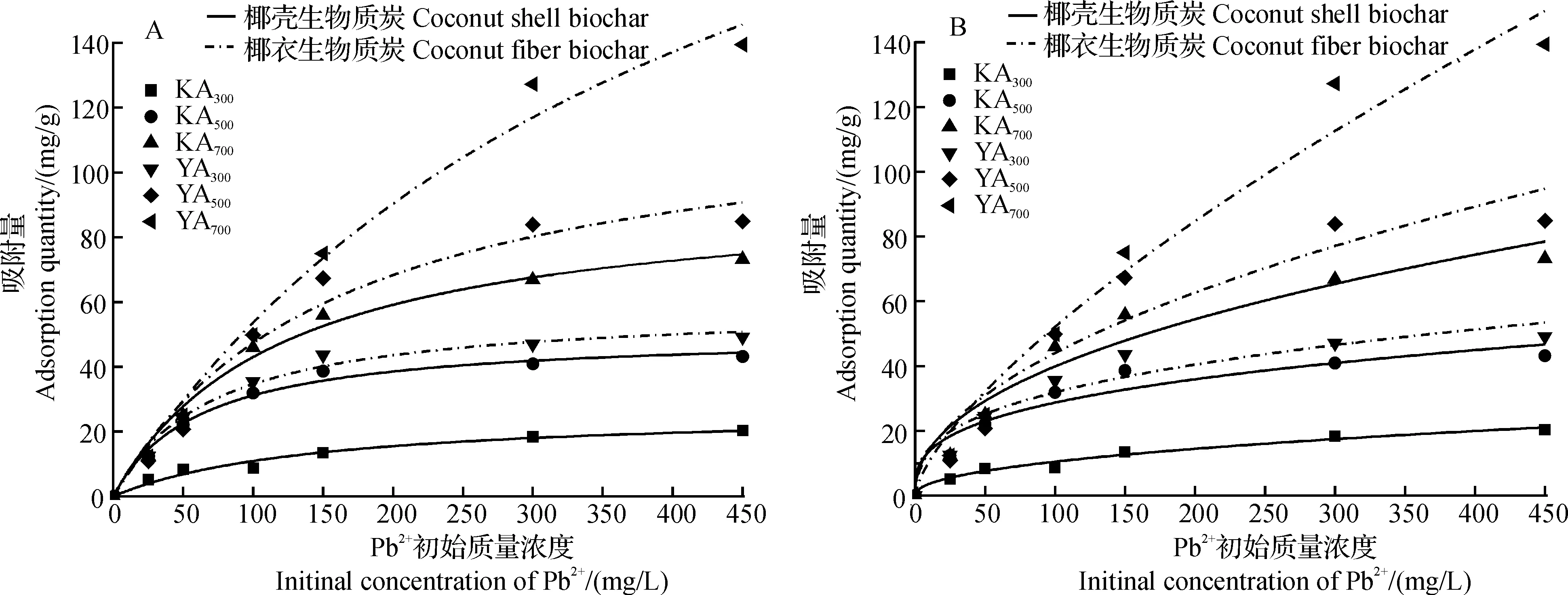
A:Langmuir模型拟合曲线;B:Freundlich模型拟合曲线。A: Fit curve by Langmuir model; B: Fit curve by Freundlich model.图3 椰衣和椰壳生物质炭对Pb2+的等温吸附曲线Fig.3 Isothermal adsorption curves of biochars from coconut fiber and coconut shell for Pb2+

生物质炭Biochars Langmuir Freundlich Qm/(mg/g)b/(L/mg)R2Kf/(mg/g)n/(g/L)R2YA30051.2060.00260.9946.5730.3430.839YA50090.3300.00180.9934.2150.5100.857YA700180.4380.00460.9922.0590.7020.958KA30032.8860.01810.9961.5930.4220.983KA50045.0150.00380.9926.4710.3230.842KA70078.4050.00170.9975.0230.4500.901
各生物质炭处理表示的含义详见表1注。Qm:最大吸附量;b:吸附平衡常数;Kf:吸附容量;n:吸附强度。
Please see footnote of Table 1 for details of each biochar treatment.Qm: Maximum adsorption capacity;b: Adsorption equilibrium constant;Kf: Adsorption capacity;n: Adsorption intensity.
表4不同提取剂对Pb2+解吸的影响
Table 4Effects of different extracting agents on desorption of Pb2+mg/g
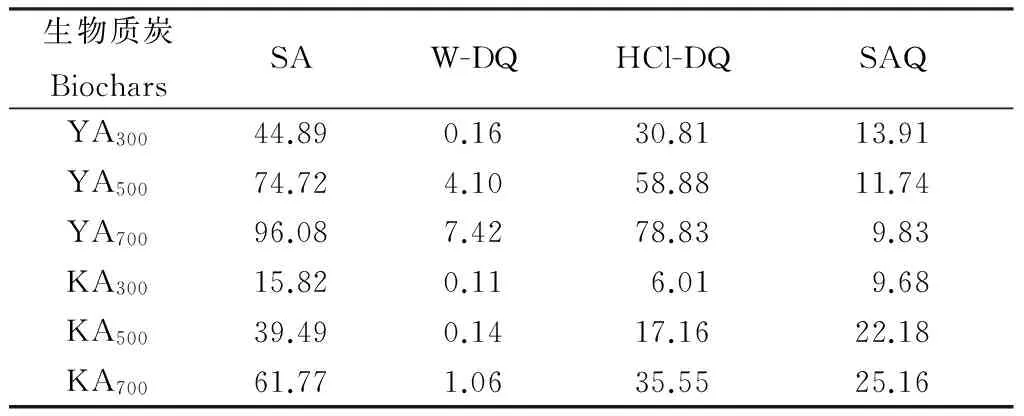
生物质炭BiocharsSAW-DQHCl-DQSAQYA30044.890.1630.8113.91YA50074.724.1058.8811.74YA70096.087.4278.839.83KA30015.820.116.019.68KA50039.490.1417.1622.18KA70061.771.0635.5525.16
各生物质炭处理表示的含义详见表1注。SA:饱和吸附量;W-DQ:去离子水解吸附量;HCl-DQ:HCl解吸附量;SAQ:稳定吸附量。
Please see footnote of Table 1 for details of each biochar treatment. SA: Saturated adsorption quantity; W-DQ: Deionized-water desorption quantity; HCl-DQ: HCl desorption quantity; SAQ: Stable adsorption quantity.
3 讨论
3.1热解温度对生物质炭理化性质的影响
椰衣和椰壳生物质炭的灰分含量随着热解温度的升高而上升,与AHMAD等[19]利用大豆秸秆、花生皮以及牛粪制备生物质炭得出的规律相同。这是由于随着热解温度的升高,有机物不断被燃烧,生物质炭本身的矿物质相对不断增加。随着热解温度的上升,生物质炭的pH值呈上升趋势,与AL-WABEL等研究得出的结果[20]类似。这是由于热解温度升高导致了酸性官能团含量减少,碱性官能团含量增加;同时,灰分含量的升高也是导致pH值上升的原因之一[10]。椰衣生物质炭的CEC总体上高于椰壳生物质炭。前人的研究表明,CEC和羧基官能团的含量以及灰分的矿物学组成(如K+、Ca2+、Mg2+等)有密切的关系[21]。通过拟合发现,在本研究中CEC和羧基官能团的含量没有明显的相关性,但是灰分含量对CEC的影响很大。
制炭温度对生物质炭的元素组成影响很大,随着热解的升高,椰衣和椰壳生物质炭H/C、O/C、(O+N)/C值呈下降趋势,这与AL-WABLE等的研究结果[20]相一致。H/C和O/C值可分别用来评估生物质炭的芳香性和极性,O/C值的下降表明生物质炭表面含氧官能团含量随热解温度的升高而减少;YA700和KA700的H/C值分别为0.42和0.36,低于其他热解温度条件下的生物质炭。这表明在700 ℃条件下制备的生物质炭的炭化强度增加[22]。
YA700和KA700的比表面积远远高出在其他热解条件下制备的生物质炭。这与AHMAD等的研究结果[19]相类似,在700 ℃条件下他们制备的2种生物质炭的比表面积分别为420和448 m2/g,远远高于用这2种材料在300 ℃条件下制备的生物质炭的比表面积(分别为6和3 m2/g)。这主要是由于高温条件去除了制炭材料本身的挥发性物质,增加了微孔体积[23]。
3.2生物质炭对Pb2+的吸附特征
椰衣和椰壳生物质炭对Pb2+的等温吸附特征符合Langmuir模型,属于单分子层吸附。随着制炭温度的升高,生物质炭对Pb2+的最大吸附量不断增加。这是由于随着温度的升高,生物质炭具有更大的比表面积和灰分含量,比表面积增大可能提供了更多的吸附位点[24],灰分的释放会加强金属离子与生物质炭表面负电荷静电吸引作用,增加对Pb2+的吸附量[25];同时,制备生物质炭产生的碳酸盐、硅酸盐以及磷酸盐可以与Pb2+反应产生沉淀[26]。CEC也是影响吸附的重要因子,CEC越大,生物质炭表面的电荷数越多,对阳离子的静电吸附作用越强[27]。与已报道的生物质炭材料对Pb2+的吸附容量比较(表5)可知,本研究得到的6种生物质炭吸附性能较好,其中,椰衣在700 ℃条件下热解产生的生物质炭(YA700)的吸附容量为180.438 mg/g(表3),大于用多数生物质材料制备的生物质炭的吸附容量。
在本研究中离子水解吸的量占吸附总量的比重很小(0.35%~7.72%)。这说明生物质炭物理吸附不是主要吸附方式,与等温吸附拟合的结果一致。HCl解吸量占吸附总量的比例很大,在38.04%~82.05%之间,其中,随着热解温度的升高,吸附了Pb2+的椰衣和椰壳生物质炭的HCl解吸量呈上升趋势,与生物质炭灰分含量的变化规律相吻合。同时,相关性分析结果显示,吸附总量和CEC、灰分的相关系数分别为0.51和0.84,呈显著正相关。这表明CEC和灰分含量是影响生物质炭吸附重金属总量的重要因子。椰衣和椰壳生物质炭对Pb2+的稳定吸附量与各制炭温度显著相关,相关系数分别为-0.99和0.94;随着热解温度的升高,椰衣生物质炭对Pb2+的稳定吸附量呈下降趋势,椰壳生物质炭对Pb2+的稳定吸附量呈上升趋势。此外,椰衣生物质炭对Pb2+的稳定吸附量为9.83~13.91 mg/g,椰壳生物质炭为9.68~25.16 mg/g。说明椰壳生物质炭比椰衣生物质炭具有更高的Pb2+稳定吸附量。生物质炭的稳定吸附量与各自的C、O含量显著相关,相关系数分别为0.85和-0.45。这表明随着热解温度的升高,生物质炭的炭化程度增加是影响吸附稳定性的主要因素。
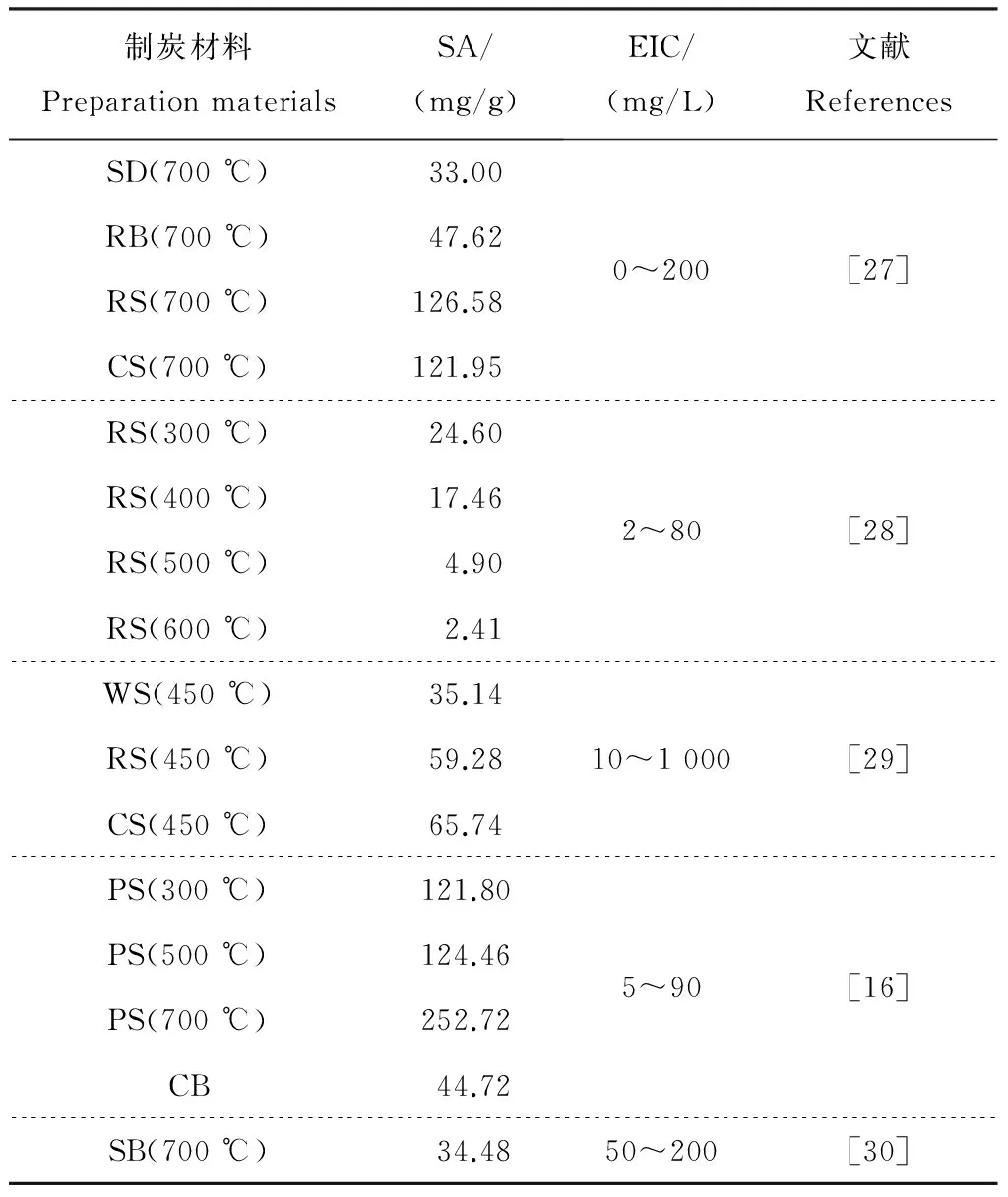
表5 多种生物质炭对Pb2+的吸附容量
SA:饱和吸附量;EIC:初始浓度范围;SD:木屑;RB:米糠;RS:水稻秸秆;CS:玉米秸秆;WS:小麦秸秆;PS:花生壳;CB:银杉木炭;SB:污泥生物质炭。
SA: Saturated adsorption quantity; EIC: Extent of initial concentration; SD: Saw dust; RB: Rice bran; RS: Rice straw; CS: Corn straw; WS: Wheat straw; PS: Peanut shell; CB: Cathaya biochar; SB: Sludge biochar.
4 结论
4.1热解温度影响椰衣和椰壳生物质炭的理化性质。热解温度由300 ℃升至 700 ℃,生物质炭H/C、(O+N)/C、O/C值下降,生物质炭的炭化程度增加,含氧官能团含量减少。生物质炭的酸性官能团随热解温度的升高而下降,而其比表面积、灰分、pH值、碱性官能团的含量随热解温度的升高而增加。
4.2椰衣和椰壳生物质炭对Pb2+的等温吸附线更符合Langmuir模型,属于单分子层吸附。随着热解温度的升高,生物质炭对Pb2+的最大吸附量增加,且椰衣生物质炭对Pb2+的最大吸附量比椰壳生物质炭高。YA700的最大吸附量为180.438 mg/g,在本文制备的6种生物质炭中最大,且大于多数用其他生物质材料制备的生物质炭。
4.3生物质炭比表面积对吸附Pb2+总量的影响很小,CEC和灰分含量是影响生物质炭吸附Pb2+的重要因子。在Pb2+溶液初始质量浓度为200 mg/L时,椰衣生物质炭对Pb2+的稳定吸附量为9.83~13.91 mg/g,椰壳生物质炭对Pb2+的稳定吸附量为9.68~25.16 mg/g。这说明椰壳生物质炭所吸附的Pb2+比椰衣生物质炭更稳定。
[1]ANTAL M J, GRØNLI M. The art, science, and technology of charcoal production.Industrial&EngineeringChemistryResearch, 2003,42(8):1619-1640.
[2]MARRIS E. Putting the carbon back: Black is the new green.Nature, 2006,442(7103):624-626.
[3]AN S, MENTLER A, MAYER H,etal. Soil aggregation, aggregate stability, organic carbon and nitrogen in different soil aggregate fractions under forest and shrub vegetation on the Loess Plateau, China.Catena, 2010,81(3):226-233.
[4]WU W, YANG M, FENG Q,etal. Chemical characterization of rice straw-derived biochar for soil amendment.BiomassandBioenergy, 2012,47:268-276.
[5]BEESLEY L, MARMIROLI M. The immobilisation and retention of soluble arsenic, cadmium and zinc by biochar.EnvironmentalPollution, 2011,159(2):474-480.
[6]National Research Council Committee on Measuring Lead in Critical Populations.MeasuringLeadExposureinInfants,Children,andOtherSensitivePopulations. Washington: National Academies Press, 1993:1-350.
[7]TANG J C, ZHU W Y, KOOKANA R,etal. Characteristics of biochar and its application in remediation of contaminated soil.JournalofBioscience&Bioengineering, 2013,116(6):653-659.
[8]XU X Y, CAO X D, ZHAO L,etal. Removal of Cu, Zn, and Cd from aqueous solutions by the dairy manure-derived biochar.EnvironmentalScienceandPollutionResearch, 2013,20(1):358-368.
[9]UCHIMIYA M, LIMA I M, THOMAS K K,etal. Immobilization of heavy metal ions (Cu(Ⅱ), Cd(Ⅱ), Ni(Ⅱ), and Pb(Ⅱ)) by broiler litter-derived biochars in water and soil.JournalofAgricultural&FoodChemistry, 2010,58(9):5538-5544.
[10]JIANG J, XU R K, JIANG T Y,etal. Immobilization of Cu(Ⅱ), Pb(Ⅱ) and Cd(Ⅱ) by the addition of rice straw derived biochar to a simulated polluted Ultisol.JournalofHazardousMaterials, 2012,229/230:145-150.
[11]DO X H, LEE B K. Removal of Pb2+using a biochar-alginate capsule in aqueous solution and capsule regeneration.JournalofEnvironmentalManagement, 2013,131:375-382.
[12]符家豪,颜春梅.海南椰子.特种经济动植物,2000,3(3):40.
FU J H, YAN C M. Coconut of Hainan.SpecialEconomicAnimalandPlant, 2000,3(3):40. (in Chinese)
[13]YUAN J H, XU R K, ZHANG H. The forms of alkalis in the biochar produced from crop residues at different temperatures.BioresourceTechnology, 2011,102(3):3488-3497.
[14]SUMNER M E, MILLER W P, SPARKS D L,etal. Cation exchange capacity and exchange coefficients//BIGHAM J M.MethodsofSoilAnalysisPart3:ChemicalMethods. Madison, Wisconsin, USA: ASA-SSSA, 1996:1201-1229.
[15]BOEHM H. Some aspects of the surface chemistry of carbon blacks and other carbons.Carbon, 1994,32:759-769.
[16]郭素华,许中坚,李方文,等.生物炭对水中Pb(Ⅱ)和Zn(Ⅱ)的吸附特征.环境工程学报,2015,9(7):3215-3222.
GUO S H, XU Z J, LI F W,etal. Adsorption of Pb(Ⅱ), Zn(Ⅱ) from aqueous solution by biochars.ChineseJournalofEnvironmentalEngineering, 2015,9(7):3215-3222. (in Chinese with English abstract)
[17]LU H, ZHANG W, YANG Y,etal. Relative distribution of Pb2+sorption mechanisms by sludge-derived biochar.WaterResearch, 2012,46(3):854-862.
[18]李力,陆宇超,刘娅,等.玉米秸秆生物炭对Cd(Ⅱ)的吸附机理研究.农业环境科学学报,2012,31(11):2277-2283.
LI L, LU Y C, LIU Y,etal. Adsorption mechanisms of cadmium on biochars derived from corn straw.JournalofAgro-EnvironmentScience, 2012,31(11):2277-2283. (in Chinese with English abstract)
[19]AHMAD M, LEE S S, YANG J E,etal. Effects of soil dilution and amendments (mussel shell, cow bone, and biochar) on Pb availability and phytotoxicity in military shooting range soil.EcotoxicologyandEnvironmentalSafety, 2012,79:225-231.
[20]AL-WABEL M I, AL-OMRAN A, EL-NAGGAR A H,etal. Pyrolysis temperature induced changes in characteristics and chemical composition of biochar produced from conocarpus wastes.BioresourceTechnology, 2013,131:374-379.

[22]CHUN Y, SHENG G, CHIOU C T,etal. Compositions and sorptive properties of crop residue-derived chars.EnvironmentalScienceTechnology, 2004,38:4649-4655.
[23]LEE J Y, LEE K K. A short note on investigation and remediation of contaminated groundwater and soil in Korea.TheJournalofEngineeringGeology, 2004,14:123-130.
[24]孟冠华,李爱民,张全兴.活性炭的表面含氧官能团及其对吸附影响的研究进展.离子交换与吸附,2007,23(1):88-94.
MENG G H, LI A M, ZHANG Q X. Studies on the oxygen-containing groups of activated carbon and their effects on the adsorption character.IonExchangeandAdsorption, 2007,23(1):88-94. (in Chinese with English abstract)
[25]楚颖超,李建宏,吴蔚东.椰纤维生物炭对Cd(Ⅱ)、As(Ⅲ)、Cr(Ⅲ)和Cr(Ⅵ)的吸附.环境工程学报,2015,9(5):2165-2170.
CHU Y C, LI J H, WU W D. Adsorption of Cd(Ⅱ), As(Ⅲ), Cr(Ⅲ) and Cr(Ⅵ) by coconut fiber-derived biochars.ChineseJournalofEnvironmentalEngineering, 2015,9(5):2165-2170. (in Chinese with English abstract)
[26]CAO X D, MA L, GAO B,etal. Dairy-manure derived biochar effectively sorbs lead and atrazine.EnvironmentalScience&Technology, 2009,43(9):3285-3291.
[27]戴静,刘阳生.4种原料热解产生的生物质炭对Pb2+和Cd2+的吸附特性研究.北京大学学报(自然科学版),2013,49(6):1075-1082.
DAI J, LIU Y S. Adsorption of Pb2+and Cd2+onto biochars derived from pyrolysis of four kinds of biomasses.ActaScientiarumNaturaliumUniversitatisPekinensis, 2013,49(6):1075-1082. (in Chinese with English abstract)
[28]安增莉,侯艳伟,蔡超,等.水稻秸秆生物炭对Pb(Ⅱ)的吸附特性.环境化学,2011,30(11):1851-1857.
AN Z L, HOU Y W, CAI C,etal. Pb2+adsorption characteristic on different biochars derived from rice straw.EnvironmentalChemistry, 2011,30(11):1851-1857. (in Chinese with English abstract)
[29]李瑞月,陈德,李恋卿,等.不同作物秸秆生物炭对溶液中Pb2+、Cd2+的吸附.农业环境科学学报,2015,34(5):1001-1008.
LI R Y, CHEN D, LI L Q,etal. Adsorption of Pb2+and Cd2+in aqueous solution by biochars derived from different crop residues.JournalofAgro-EnvironmentScience, 2015,34(5):1001-1008. (in Chinese with English abstract)
[30]丁文川,杜勇,曾晓岚,等.富磷污泥生物炭去除水中Pb(Ⅱ)的特性研究.环境化学,2012,31(9):1375-1380.
DING W C, DU Y, ZENG X L,etal. A study on characteristics and adsorption of Pb2+in aqueous solution by rich P sludge biochar.EnvironmentalChemistry, 2012,31(9):1375-1380. (in Chinese with English abstract)
Preparation of biochars from coconut fiber and coconut shell and their adsorption for Pb2+in solution.JournalofZhejiangUniversity(Agric. &LifeSci.), 2016,42(4):469-477
LAN Tian1,2, CHU Yingchao1, ZHANG Lingling1, ZHAO Wen1, PAN Yunzhou1,2, ZHANG Jiawei1, ZHU Zhiqiang1, WU Weidong1*
(1.KeyLaboratoryofProtectionandDevelopmentUtilizationofTropicalCropGermplasmResources,MinistryofEducation,HainanUniversity,Haikou570228,China; 2.HainanKeyLaboratoryofArableLandConservation,HainanAcademyofAgriculturalSciences,Haikou571100,China)
coconut fiber; coconut shell; biochar; pyrolysis temperature; physical and chemical properties; adsorption; Pb2+
国家自然科学基金(B070303);海南省耕地保育重点实验室(筹建)开放资金(KFZJ20150203).
Corresponding author):吴蔚东(http://orcid.org/0000-0002-9676-5715),E-mail:wdwu@hainu.edu.cn
联系方式:兰天(http://orcid.org/0000-0002-4222-6863),E-mail:lantiancnnm@163.com
2015-12-10;接受日期(Accepted):2016-04-08;网络出版日期(Published online):2016-07-18
X 131; X 53
A
URL:http://www.cnki.net/kcms/detail/33.1247.S.20160718.2011.002.html

